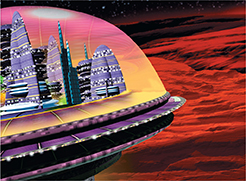25.3 The Inner Solar System
Reading Focus
Key Concepts
 How are the inner planets similar?
How are the inner planets similar? What are the characteristics of each of the four inner planets?
What are the characteristics of each of the four inner planets? What are asteroids and how were they formed?
What are asteroids and how were they formed?
Vocabulary
terrestrial planets
asteroids
asteroid belt
Reading Strategy
Summarizing Make a table like the one below that includes all the headings for the section. Write a brief summary of the text for each heading.
The Terrestrial Planets
Four planets closest to the sun
Small, dense, with rocky surfaces
Mercury
________________________________
Venus
________________________________
Suppose that you wanted to set up a colony on another planet. Which planet would you choose? Venus is the nearest planet and is similar to Earth in size. But Venus is extremely hot and has an atmosphere that is so thick it would crush any potential colonists. Mercury is closest to the sun, but it has no atmosphere. Temperatures there are either far too high or far too low to support life.
Your best choice would be Mars. However, a permanent colony on Mars, like the one pictured in Figure 11, would face very difficult conditions. Mars is usually extremely cold and has a very thin atmosphere with no oxygen. Huge dust storms blow across the planet. Although NASA is considering sending astronauts to Mars, it would take an incredible effort to set up a permanent colony under such harsh conditions.
The Terrestrial Planets
The four planets closest to the sun—Mercury, Venus, Earth, and Mars—are often called the terrestrial planets. The terrestrial planets are planets similar in structure to Earth. (Terra is the Latin word for “Earth.”)  The four inner planets are all relatively small and dense, and have rocky surfaces. Like Earth, they all have a crust, mantle, and iron core.
The four inner planets are all relatively small and dense, and have rocky surfaces. Like Earth, they all have a crust, mantle, and iron core.
All of the terrestrial planets have rocky crusts. Mercury and Mars have surfaces that are pockmarked by craters. On Earth and Venus, most craters have disappeared because the surface is continually being altered. The surfaces of the other terrestrial planets change much more slowly, so more craters are visible.
Figure 11 This imaginative painting shows a possible future human settlement on Mars. Settlers might live in domes to protect themselves from the harsh climate and to provide an atmosphere for breathing.





